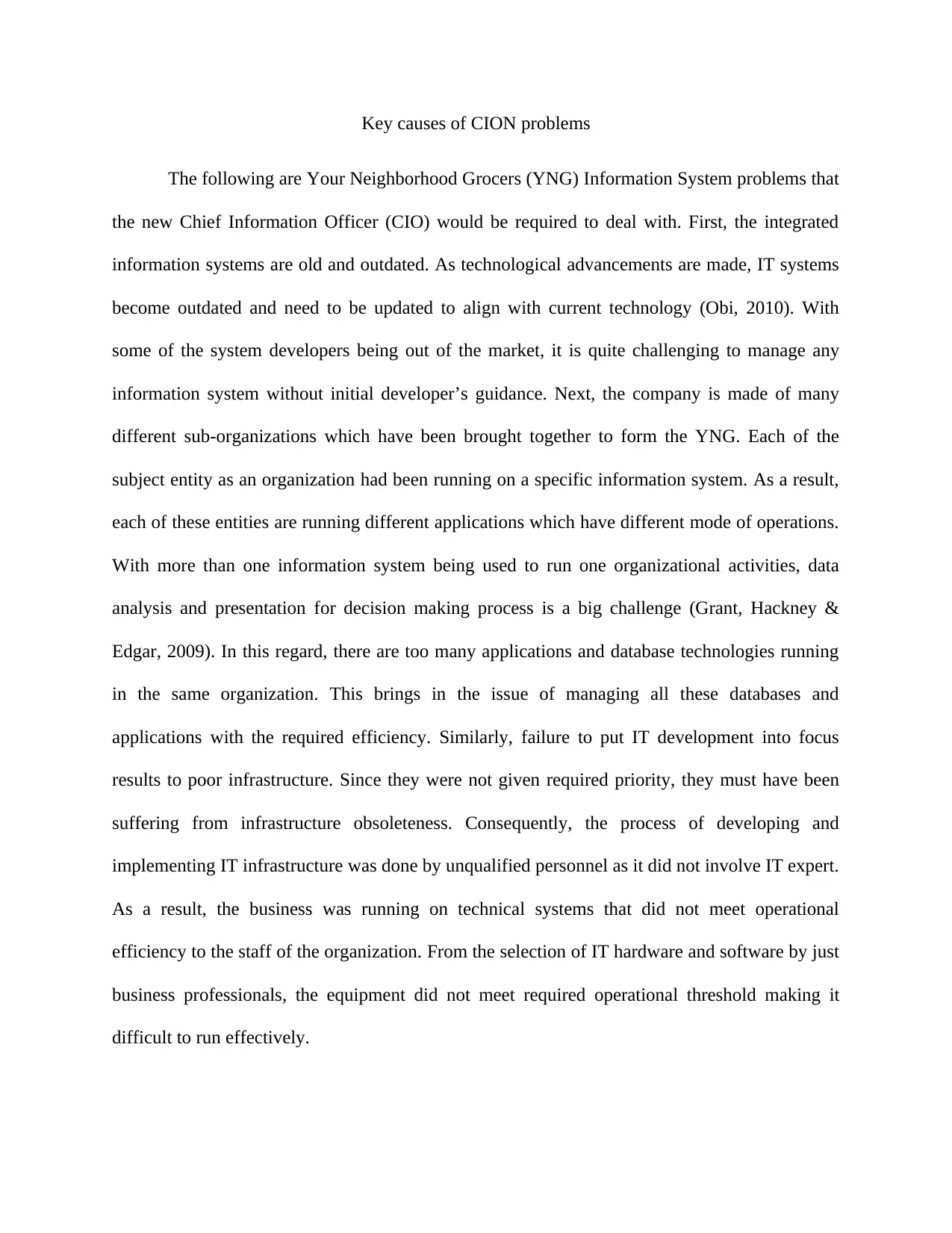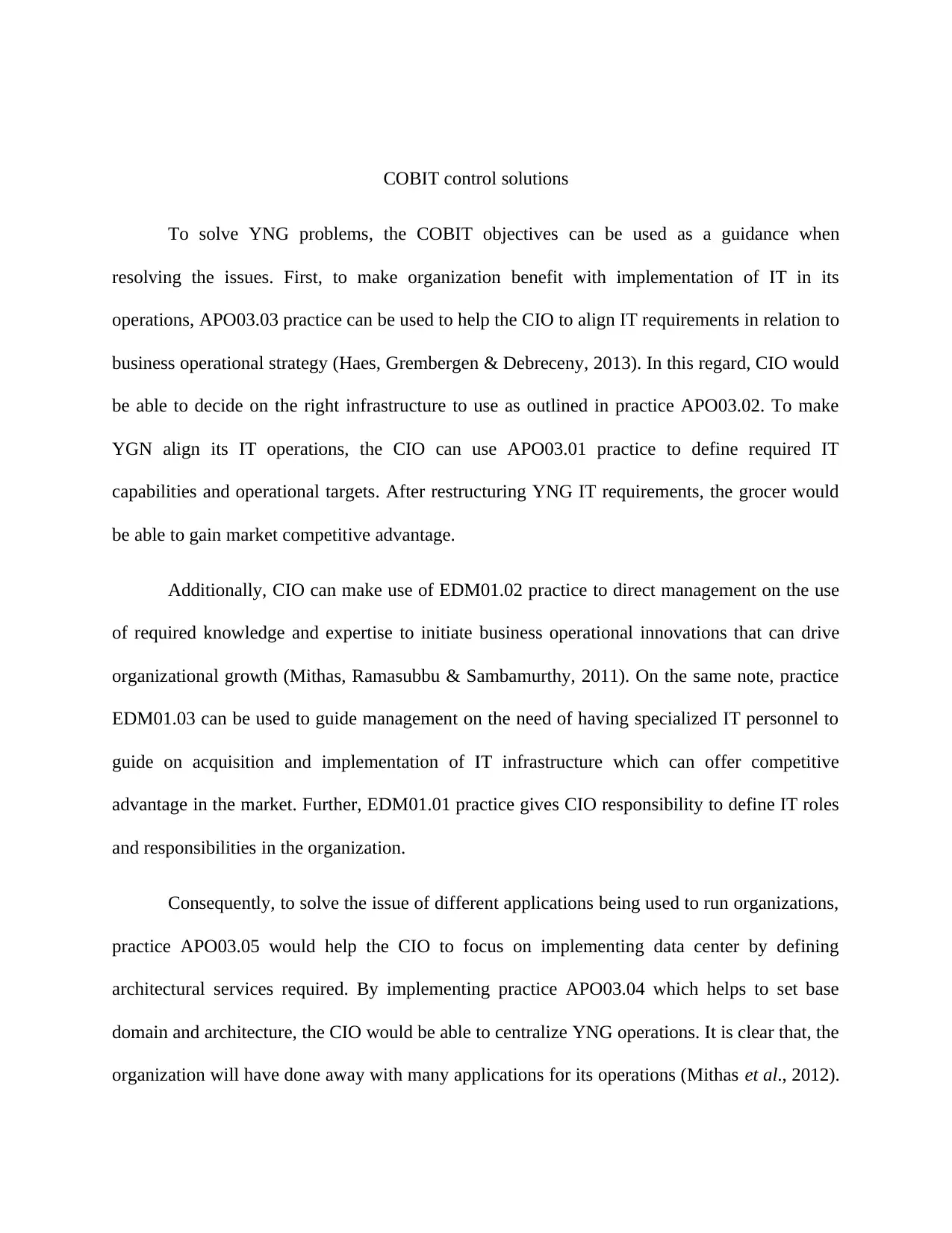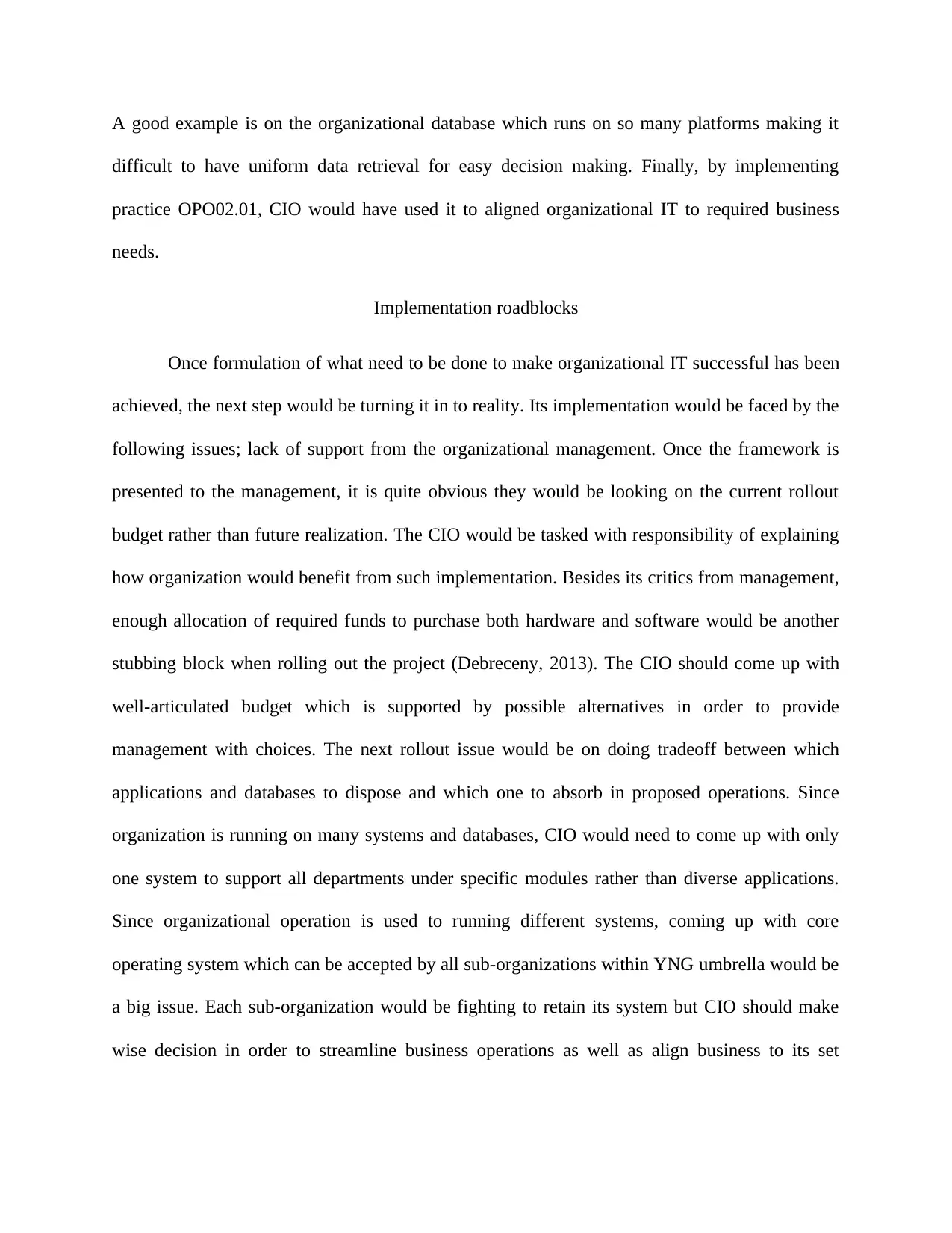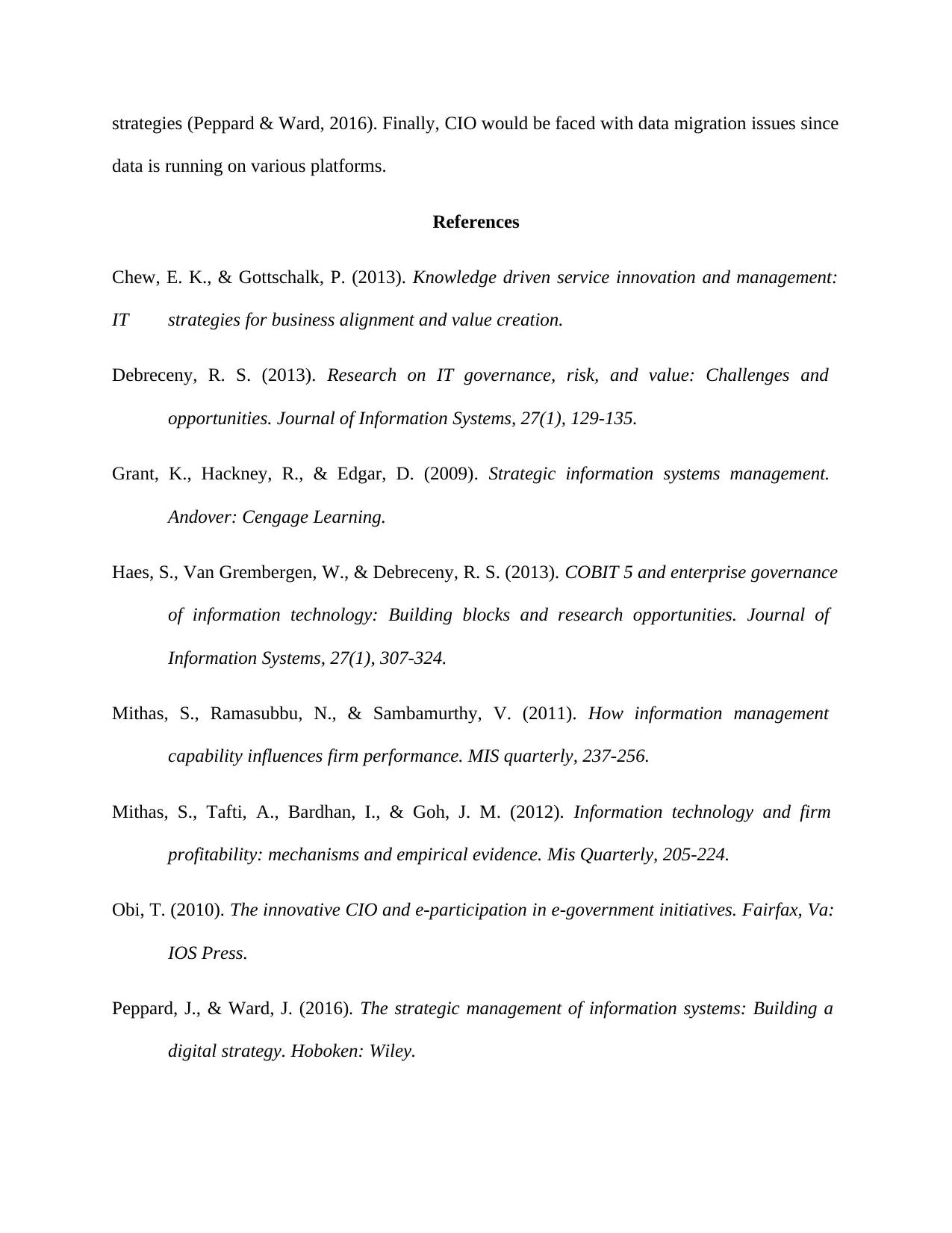YNG: Analysis of Information System Challenges and Solutions
VerifiedAdded on 2021/06/14
|6
|1237
|30
Report
AI Summary
This report analyzes the information system problems faced by Your Neighborhood Grocers (YNG). The key issues include outdated and fragmented IT systems due to mergers, leading to challenges in data analysis, multiple applications, and poor infrastructure. The report proposes COBIT objectives as solutions, particularly focusing on aligning IT with business strategies, defining IT capabilities, and centralizing operations. The report suggests the CIO use EDM01.02, EDM01.03, EDM01.01 practices. Furthermore, it highlights implementation roadblocks such as lack of management support, budget constraints, decisions on which applications to retain, and data migration issues. The report emphasizes the need for a well-articulated budget, streamlined systems, and addressing data migration complexities to ensure successful IT implementation and alignment with YNG's business goals. References are included.

Your Neighborhood Grocers analysis
Name
Institution
Professor
Course
Date
Name
Institution
Professor
Course
Date
Paraphrase This Document
Need a fresh take? Get an instant paraphrase of this document with our AI Paraphraser

Key causes of CION problems
The following are Your Neighborhood Grocers (YNG) Information System problems that
the new Chief Information Officer (CIO) would be required to deal with. First, the integrated
information systems are old and outdated. As technological advancements are made, IT systems
become outdated and need to be updated to align with current technology (Obi, 2010). With
some of the system developers being out of the market, it is quite challenging to manage any
information system without initial developer’s guidance. Next, the company is made of many
different sub-organizations which have been brought together to form the YNG. Each of the
subject entity as an organization had been running on a specific information system. As a result,
each of these entities are running different applications which have different mode of operations.
With more than one information system being used to run one organizational activities, data
analysis and presentation for decision making process is a big challenge (Grant, Hackney &
Edgar, 2009). In this regard, there are too many applications and database technologies running
in the same organization. This brings in the issue of managing all these databases and
applications with the required efficiency. Similarly, failure to put IT development into focus
results to poor infrastructure. Since they were not given required priority, they must have been
suffering from infrastructure obsoleteness. Consequently, the process of developing and
implementing IT infrastructure was done by unqualified personnel as it did not involve IT expert.
As a result, the business was running on technical systems that did not meet operational
efficiency to the staff of the organization. From the selection of IT hardware and software by just
business professionals, the equipment did not meet required operational threshold making it
difficult to run effectively.
The following are Your Neighborhood Grocers (YNG) Information System problems that
the new Chief Information Officer (CIO) would be required to deal with. First, the integrated
information systems are old and outdated. As technological advancements are made, IT systems
become outdated and need to be updated to align with current technology (Obi, 2010). With
some of the system developers being out of the market, it is quite challenging to manage any
information system without initial developer’s guidance. Next, the company is made of many
different sub-organizations which have been brought together to form the YNG. Each of the
subject entity as an organization had been running on a specific information system. As a result,
each of these entities are running different applications which have different mode of operations.
With more than one information system being used to run one organizational activities, data
analysis and presentation for decision making process is a big challenge (Grant, Hackney &
Edgar, 2009). In this regard, there are too many applications and database technologies running
in the same organization. This brings in the issue of managing all these databases and
applications with the required efficiency. Similarly, failure to put IT development into focus
results to poor infrastructure. Since they were not given required priority, they must have been
suffering from infrastructure obsoleteness. Consequently, the process of developing and
implementing IT infrastructure was done by unqualified personnel as it did not involve IT expert.
As a result, the business was running on technical systems that did not meet operational
efficiency to the staff of the organization. From the selection of IT hardware and software by just
business professionals, the equipment did not meet required operational threshold making it
difficult to run effectively.

COBIT control solutions
To solve YNG problems, the COBIT objectives can be used as a guidance when
resolving the issues. First, to make organization benefit with implementation of IT in its
operations, APO03.03 practice can be used to help the CIO to align IT requirements in relation to
business operational strategy (Haes, Grembergen & Debreceny, 2013). In this regard, CIO would
be able to decide on the right infrastructure to use as outlined in practice APO03.02. To make
YGN align its IT operations, the CIO can use APO03.01 practice to define required IT
capabilities and operational targets. After restructuring YNG IT requirements, the grocer would
be able to gain market competitive advantage.
Additionally, CIO can make use of EDM01.02 practice to direct management on the use
of required knowledge and expertise to initiate business operational innovations that can drive
organizational growth (Mithas, Ramasubbu & Sambamurthy, 2011). On the same note, practice
EDM01.03 can be used to guide management on the need of having specialized IT personnel to
guide on acquisition and implementation of IT infrastructure which can offer competitive
advantage in the market. Further, EDM01.01 practice gives CIO responsibility to define IT roles
and responsibilities in the organization.
Consequently, to solve the issue of different applications being used to run organizations,
practice APO03.05 would help the CIO to focus on implementing data center by defining
architectural services required. By implementing practice APO03.04 which helps to set base
domain and architecture, the CIO would be able to centralize YNG operations. It is clear that, the
organization will have done away with many applications for its operations (Mithas et al., 2012).
To solve YNG problems, the COBIT objectives can be used as a guidance when
resolving the issues. First, to make organization benefit with implementation of IT in its
operations, APO03.03 practice can be used to help the CIO to align IT requirements in relation to
business operational strategy (Haes, Grembergen & Debreceny, 2013). In this regard, CIO would
be able to decide on the right infrastructure to use as outlined in practice APO03.02. To make
YGN align its IT operations, the CIO can use APO03.01 practice to define required IT
capabilities and operational targets. After restructuring YNG IT requirements, the grocer would
be able to gain market competitive advantage.
Additionally, CIO can make use of EDM01.02 practice to direct management on the use
of required knowledge and expertise to initiate business operational innovations that can drive
organizational growth (Mithas, Ramasubbu & Sambamurthy, 2011). On the same note, practice
EDM01.03 can be used to guide management on the need of having specialized IT personnel to
guide on acquisition and implementation of IT infrastructure which can offer competitive
advantage in the market. Further, EDM01.01 practice gives CIO responsibility to define IT roles
and responsibilities in the organization.
Consequently, to solve the issue of different applications being used to run organizations,
practice APO03.05 would help the CIO to focus on implementing data center by defining
architectural services required. By implementing practice APO03.04 which helps to set base
domain and architecture, the CIO would be able to centralize YNG operations. It is clear that, the
organization will have done away with many applications for its operations (Mithas et al., 2012).
⊘ This is a preview!⊘
Do you want full access?
Subscribe today to unlock all pages.

Trusted by 1+ million students worldwide

A good example is on the organizational database which runs on so many platforms making it
difficult to have uniform data retrieval for easy decision making. Finally, by implementing
practice OPO02.01, CIO would have used it to aligned organizational IT to required business
needs.
Implementation roadblocks
Once formulation of what need to be done to make organizational IT successful has been
achieved, the next step would be turning it in to reality. Its implementation would be faced by the
following issues; lack of support from the organizational management. Once the framework is
presented to the management, it is quite obvious they would be looking on the current rollout
budget rather than future realization. The CIO would be tasked with responsibility of explaining
how organization would benefit from such implementation. Besides its critics from management,
enough allocation of required funds to purchase both hardware and software would be another
stubbing block when rolling out the project (Debreceny, 2013). The CIO should come up with
well-articulated budget which is supported by possible alternatives in order to provide
management with choices. The next rollout issue would be on doing tradeoff between which
applications and databases to dispose and which one to absorb in proposed operations. Since
organization is running on many systems and databases, CIO would need to come up with only
one system to support all departments under specific modules rather than diverse applications.
Since organizational operation is used to running different systems, coming up with core
operating system which can be accepted by all sub-organizations within YNG umbrella would be
a big issue. Each sub-organization would be fighting to retain its system but CIO should make
wise decision in order to streamline business operations as well as align business to its set
difficult to have uniform data retrieval for easy decision making. Finally, by implementing
practice OPO02.01, CIO would have used it to aligned organizational IT to required business
needs.
Implementation roadblocks
Once formulation of what need to be done to make organizational IT successful has been
achieved, the next step would be turning it in to reality. Its implementation would be faced by the
following issues; lack of support from the organizational management. Once the framework is
presented to the management, it is quite obvious they would be looking on the current rollout
budget rather than future realization. The CIO would be tasked with responsibility of explaining
how organization would benefit from such implementation. Besides its critics from management,
enough allocation of required funds to purchase both hardware and software would be another
stubbing block when rolling out the project (Debreceny, 2013). The CIO should come up with
well-articulated budget which is supported by possible alternatives in order to provide
management with choices. The next rollout issue would be on doing tradeoff between which
applications and databases to dispose and which one to absorb in proposed operations. Since
organization is running on many systems and databases, CIO would need to come up with only
one system to support all departments under specific modules rather than diverse applications.
Since organizational operation is used to running different systems, coming up with core
operating system which can be accepted by all sub-organizations within YNG umbrella would be
a big issue. Each sub-organization would be fighting to retain its system but CIO should make
wise decision in order to streamline business operations as well as align business to its set
Paraphrase This Document
Need a fresh take? Get an instant paraphrase of this document with our AI Paraphraser

strategies (Peppard & Ward, 2016). Finally, CIO would be faced with data migration issues since
data is running on various platforms.
References
Chew, E. K., & Gottschalk, P. (2013). Knowledge driven service innovation and management:
IT strategies for business alignment and value creation.
Debreceny, R. S. (2013). Research on IT governance, risk, and value: Challenges and
opportunities. Journal of Information Systems, 27(1), 129-135.
Grant, K., Hackney, R., & Edgar, D. (2009). Strategic information systems management.
Andover: Cengage Learning.
Haes, S., Van Grembergen, W., & Debreceny, R. S. (2013). COBIT 5 and enterprise governance
of information technology: Building blocks and research opportunities. Journal of
Information Systems, 27(1), 307-324.
Mithas, S., Ramasubbu, N., & Sambamurthy, V. (2011). How information management
capability influences firm performance. MIS quarterly, 237-256.
Mithas, S., Tafti, A., Bardhan, I., & Goh, J. M. (2012). Information technology and firm
profitability: mechanisms and empirical evidence. Mis Quarterly, 205-224.
Obi, T. (2010). The innovative CIO and e-participation in e-government initiatives. Fairfax, Va:
IOS Press.
Peppard, J., & Ward, J. (2016). The strategic management of information systems: Building a
digital strategy. Hoboken: Wiley.
data is running on various platforms.
References
Chew, E. K., & Gottschalk, P. (2013). Knowledge driven service innovation and management:
IT strategies for business alignment and value creation.
Debreceny, R. S. (2013). Research on IT governance, risk, and value: Challenges and
opportunities. Journal of Information Systems, 27(1), 129-135.
Grant, K., Hackney, R., & Edgar, D. (2009). Strategic information systems management.
Andover: Cengage Learning.
Haes, S., Van Grembergen, W., & Debreceny, R. S. (2013). COBIT 5 and enterprise governance
of information technology: Building blocks and research opportunities. Journal of
Information Systems, 27(1), 307-324.
Mithas, S., Ramasubbu, N., & Sambamurthy, V. (2011). How information management
capability influences firm performance. MIS quarterly, 237-256.
Mithas, S., Tafti, A., Bardhan, I., & Goh, J. M. (2012). Information technology and firm
profitability: mechanisms and empirical evidence. Mis Quarterly, 205-224.
Obi, T. (2010). The innovative CIO and e-participation in e-government initiatives. Fairfax, Va:
IOS Press.
Peppard, J., & Ward, J. (2016). The strategic management of information systems: Building a
digital strategy. Hoboken: Wiley.

⊘ This is a preview!⊘
Do you want full access?
Subscribe today to unlock all pages.

Trusted by 1+ million students worldwide
1 out of 6
Related Documents
Your All-in-One AI-Powered Toolkit for Academic Success.
+13062052269
info@desklib.com
Available 24*7 on WhatsApp / Email
![[object Object]](/_next/static/media/star-bottom.7253800d.svg)
Unlock your academic potential
Copyright © 2020–2025 A2Z Services. All Rights Reserved. Developed and managed by ZUCOL.




